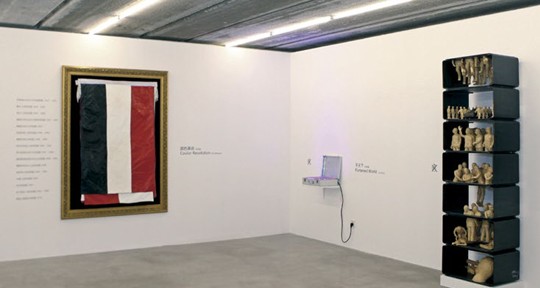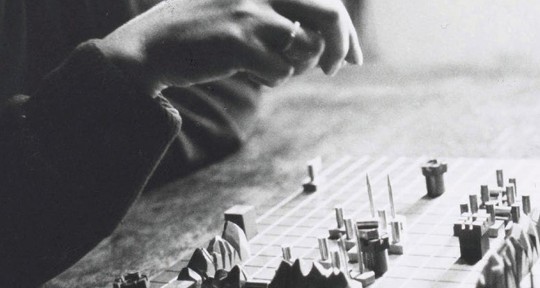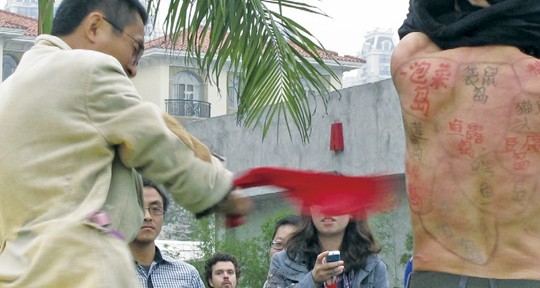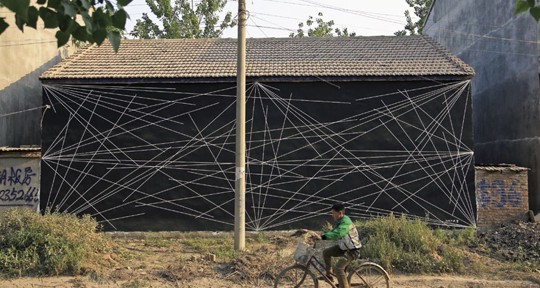In the 1830s, the electric telegraph was invented. It was designed to organize English characters and punctuation according to the frequency with which they occur in text, and then establish a set of rules. Combinations of dots and dashes were used to represent each letter or sign, those occurring most frequently possessing the shortest assignments….
Read MoreOne salient feature of the exhibition “From Gesture to Language” is the anachronistic juxtaposition of ancient and contemporary. This is perhaps due to the participation of curator Pascal Torres Guardiola, who heads the department of chalcography—engravings, lithographs, and other printed matters—at the Louvre. The longstanding historical connection between engraving and printing in European arts here…
Read MoreIn 1989, two wildfires raged through Taiwanese society, leaving devastation and pain in their paths, while they continue burning to this day. In Su Yu-Hsien’s solo exhibition at TKG+ gallery, “Hua-shan-qiang,” these furious flames are refracted through the exhibition—photographs, a narrative video, and on-site installations—and the result is a beautiful yet tragic world rooted in…
Read MoreThe projection in “Entropy Wrangler,” Ian Cheng’s solo exhibition at Matt Moravec’s new space Off Vendome, is not a video work. It is a program where elements exist in a space defined by forces of causation individual to each figure. Projected in the basement of the Off Vendome space, Moravec describes it as a video…
Read MoreChen Zhou holds a knife to his wrist but doesn’t press down. This event early in his new film seems to express the artist’s present state more precisely than anything else—“I want to, but I can’t.” In Chen’s previous work Spanking the Maid, the same “inability” can be found, only on this occasion, the identity…
Read MoreFor readers unable to visit this exhibition in person: The perspective in the photograph to the left appears even stranger in real life. Ignore the stove, clay models, and flames and there is another perspective in a male figure, its body pierced several times with knives, looming gargantuan amongst “mountains.” Gazing beyond him to the…
Read MoreThe exhibition opens with two photographs of the artist, Tang Song, being taken away by police, stepping on the logo of “no returns” of the “China Avant-Garde Exhibition” at the National Art Museum in 1989. In a letter Tang Song had written to the late Dutch archivist Hans van Dijk soon after his release from…
Read MoreAround 30 years ago, Italo Calvino used a story from the Boccaccio classic The Decameron in a lecture as a prime illustration of the concept of “lightness.” Boccaccio paints the portrait of a hermetic Florentine poet in Guido Cavalcanti, the refined and solemn philosopher who is distrusted and cast out by Florence’s profligate socialites and…
Read MoreIn his work , Zhao Yao has found a sound and sustainable mode of exhibition that he calls “serial performance.” Born out of his suspicion with regard to all of the formalized complacencies created by contemporary art, the method allows him to engage in ongoing strikes against mechanisms of the exhibition as well as of…
Read MoreTHE ART FAIR as we know it is no longer free to exist in and of itself. Come vernissage or even earlier, local arts and culture organizations are now bound like lemmings to organize their own spinoff ordeals. An art fair is not a proper art fair without a full roster of ancillary events and…
Read MoreAlthough “Wang Peng: A Crowd of One” is billed as a retrospective of the artist’s 30-year career, one has difficulty placing the exhibition inside an existing art historical framework. Many a typical retrospective would have the artist carefully select the works shown, exhibition approach, and the venue. The artist would pay close attention to the…
Read MoreThis Su Wenxiang-curated exhibition possesses a title that immediately conjures an atmosphere of political opposition. Yet the title seems dissociated from the exhibition itself, lingering instead by the gallery entrance, or drifting like a soft cloud above the visitor’s head. During its travels between the mouths of its visitors, it is soon simplified into an…
Read MoreIn 2011, Guo Hongwei created three collage works, Shadow in Shadows, The Sunshine Behind the Sunshine, and Highlight of Highlights. His practice fragmented somewhat, and he engaged in various different projects; in a collaboration with an art and fashion magazine, Guo again employed manual, cut-and-paste collage techniques, transforming advertisements into a formal structure, illusory in…
Read MoreWhen put forward as a philosophical concept, “the multitude” must find a way for its subjectivity— in the context of new capitalist constructs, like cognitive capitalism, which carry such potential for conspired action and integration—to realize true diversity and differentiation in the “decision” to sustain itself. As compared to the way in which the notion…
Read MoreIn Claes Oldenburg’s 1960 statement “I am for an Art,” the artist gives his written phrases the same vivid palette and wily elasticity as his genre-defying artwork. The piece would soon be hailed not only as the artist’s personal manifesto, but also a mantra for American Pop Art, which at that moment was busy chipping…
Read MoreRelationships start with a choice: to open up to a stranger or recoil. That choice, common as it is in encounters between individuals, is just as relevant when thinking about cultures coming into contact with one another—when friendship becomes a matter of war and peace. These meetings might produce a cacophonous event: like the 2011…
Read More“Un art de la guerre”—this is the subtitle of the spring 2013 Guy Debord (1931-1994) documentary exhibition at the Bibliotheque nationale de France (BnF). An iconoclastic thinker, artist, and political activist, Debord scorned honors and organs of authority throughout his life and attacked what he called “the Society of the Spectacle.” Today, his manuscripts have…
Read MoreTen years ago, when we talked about Chinese performance art, one would typically refer to controversial actions like eating a fetus. However, one should not forget that there were also Xiamen Dada’s burning of artworks after exhibition (1986), Xiao Lu and Tang Song’s shooting incident at the “China Modern Art Exhibition” (1989), the Beijing East…
Read MoreThe art world’s increasing interest in Southeast Asia in recent years is indisputable. Last year’s Art Dubai welcomed Alia Swastika to curate its Southeast Asian-focused “Marker” section. In late May, Christie’s Hong Kong offered up its largest-ever lot of contemporary wares from the region. Perhaps most tellingly, this year also witnessed the Guggenheim hold “No…
Read MoreThe openness of contemporary art with regard to medium and context allows for a wider range of formal possibilities, and its social orientation also serves to consistently expand the limits of these. …
Read More







